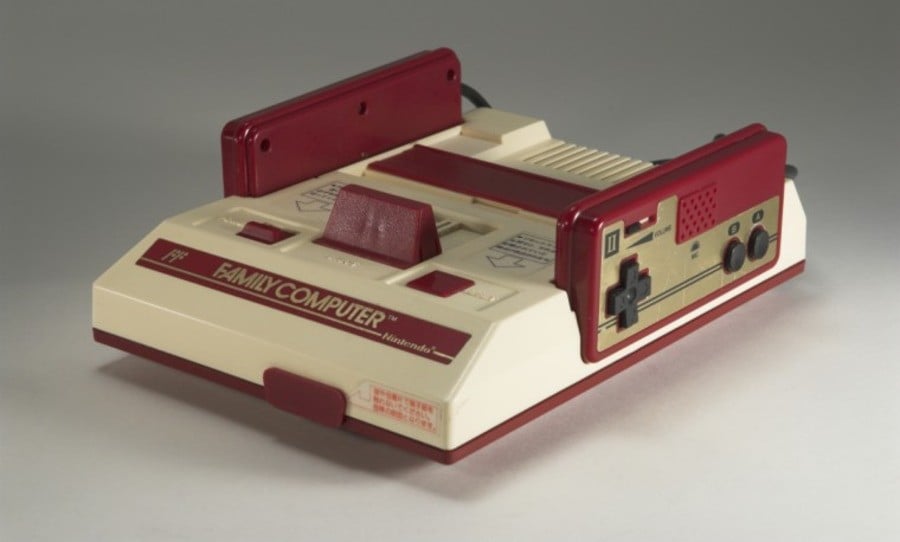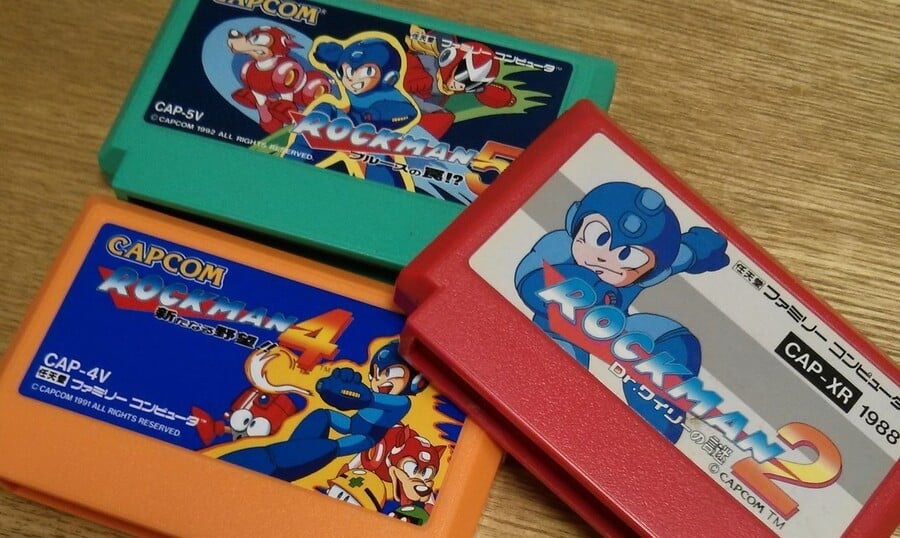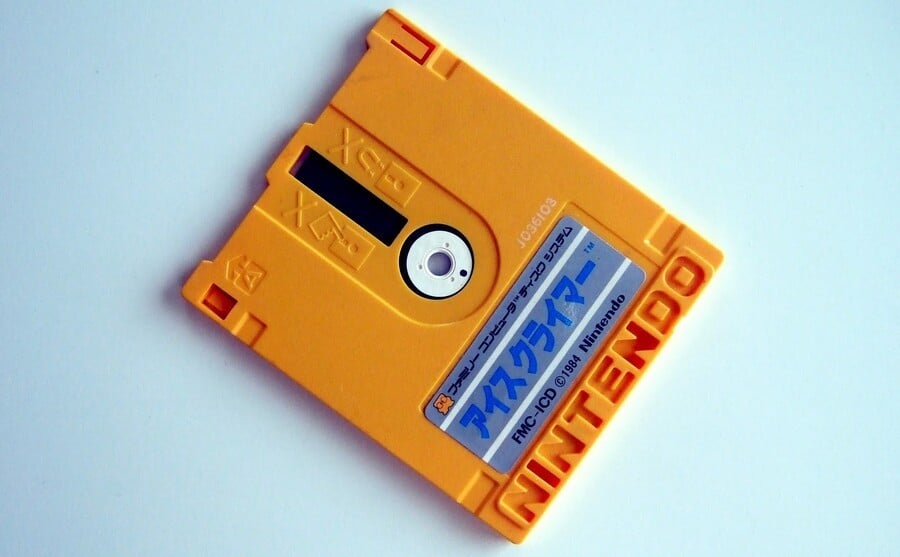
Nintendo may be a company with a history that stretches back over a hundred years, but it has only enjoyed its current level of fame for the past thirty or so — and that’s largely thanks to a remarkable 8-bit console which launched in its native Japan three decades ago this week. The Family Computer — or Famicom for short — was a revolutionary product; born out of Nintendo’s desire to capitalize on its successful arcade business, it would go on to achieve the kind of domination that is rarely seen in this business. During its height, the Famicom was the Japanese console industry; almost every house in the country that contained children had Nintendo's console under the TV, and developers were so desperate to make games for it that they would gladly forego any chance to publish on rival formats; if it didn’t have the name “Nintendo” on the casing, it didn’t matter.
The Famicom began life as the “GameCom” before system designer Masayuki Uemura’s wife suggested the moniker we know and love today. During development several ideas were bandied about, including the concept of creating a powerful home computer complete with a keyboard and disk drive, but ultimately the console became the diminutive red-and-white wonder that has become so iconic over the years; the colour scheme was apparently chosen by Nintendo president Hiroshi Yamauchi after he spotted a billboard advertisement which used the same hues.
Subscribe to Nintendo Life on YouTube841k
Despite a desire to create a product which could be manufactured as cheaply as possible — thus maximising profitability — Nintendo’s designers were incredibly picky when it came to components. One of the system's two controllers (both of which were hard-wired to the machine, again to save costs) contained a microphone which could be used to influence gameplay. The company even created the Famicom’s cartridge connectors internally to ensure quality, and the inclusion of an “eject” button — a totally superfluous element — was down to Uemura’s belief that children would find the mechanism enjoyable to use even when they weren’t playing on the system.

The designer of the console may have underestimated the addictive qualities of the Famicom, because fiddling with the eject button was the last thing on the mind of most young players. Although an early manufacturing setback forced a full-scale recall (instigated by Yamauchi, who was keen to protect his company’s good name), the console would become Japan’s best-selling domestic gaming system by the end of 1984. Backed by arcade conversions of the company's most popular titles — such as Donkey Kong and Popeye — the Famicom was a sensation, but it was Shigeru Miyamoto’s Super Mario Bros. in 1985 which asserted the format’s dominance — by the time it reached the market, the Famicom had sold in excess of 2.5 million units in Japan, a success which triggered Nintendo’s move to launch the console in North America, where the industry was still reeling from the 1983 video game crash.
Ironically, Super Mario Bros. was pitched internally as something of a swansong for the Famicom, as Nintendo was about to release the Famicom Disk System, a bolt-on device which would enable developers to make cheaper games and allow players to re-use the disks thanks to the rewritable nature or the media. Despite a huge development push (The Legend of Zelda, Metroid and Kid Icarus all began life as Famicom Disk System exclusives) the peripheral was not the runaway success Nintendo had envisaged; it was plagued by reliability issues and after a few years the benefits offered — more storage space and cheaper games — effectively ceased to exist as memory prices dropped and cartridges subsequently became larger and less costly. Therefore, the stand-alone Famicom once again became Nintendo’s primary focus, and 1988’s Super Mario Bros. 3 — arguably the biggest title on the format — was only available on cartridge.
Such was the utter dominance of the Famicom in its home territory that third-party developers like Square, Namco, Capcom and Konami were more than happy to sign away their freedom in order to get their games onto Nintendo’s hardware. All would agree to stipulations which prevented them from producing software for Nintendo’s rivals, a shady move which effectively ended Sega’s chances of challenging the Famicom’s rule with its SG-1000 and Mark III consoles. Nintendo’s vice-like grip on the Japanese games industry was so absolute that many third party publishers saw their profits expand dramatically almost overnight, almost entirely down to the fact that they had games on the Famicom — and this only served to strengthen their loyalty.

Not all publishers were happy with this situation, despite the obvious benefits Nintendo gave them. Namco founder Masaya Nakamura publicly voiced his discontent at the amount of power and control that Nintendo had, prompting an equally public dismissal from Yamauchi himself. Facing the prospect of losing the bumper profits generated from the relationship with Nintendo, Nakamura and Namco sheepishly re-signed the agreement, although the company would be one of the first to lend its support to rival systems in later years, such as the PC Engine and Sega Mega Drive.
Following the North American launch of the Nintendo Entertainment System — the western version of the Famicom — in 1985, Nintendo’s stature grew even more. The NES enjoyed the same kind of success state-side as its Japanese counterpart had done in its homeland; developers were once again locked-down with agreements which forbade them from releasing their games on other formats, and Nintendo of America even went as far as to introduce the NES10 chip, ostensibly to curb the danger of unlicensed software watering down the pool of quality games available on the market, but also to make doubly sure that no publisher could create cartridges without paying Nintendo first.
By the time the 16-bit war started, the Famicom and NES could be found in around 60 million homes worldwide — a remarkable achievement for the time, given the small size of the industry compared to where it stands now. Its legacy simply cannot be understated; many of Nintendo’s most significant franchises were born on the console, and it laid down the foundations of a third-party publishing model which remains in place even to this day — although it could be argued that download services such as the iTunes App Store and Google Play market are slowly but surely pulling the system apart, empowering developers rather than hardware manufacturers. Even so, the video game industry would not have gotten to its current size and stature without the Famicom, or Nintendo.
Main image courtesy of the National Media Museum.





Comments 28
Those Famicom colours... I hope another system will get this makeover, since the Game Boy Micro Famicom Edition is simply GORGEOUS! It's the best looking gaming device ever in my opinion. Unless it needs to radiate true joy, then the Pikachu N64 wins.
And now THEY want to see Nintendo die.
sorry to say that i've never played, or ever seen, a famicom (NES) in my life, although i still respect it as i have played many of its games.
That's what the FAMICOM looks like? OMG! It might have essentially been the same machine but the NES is hideous by comparison! Why was ours so grey? Why did our controllers not have speakers or microphones? We got screwed!
Actually I think our controllers looked better but that's besides the point.
This article is totally incorrect. It was Nintendo of America with the NES that insisted on exclusivity.
In Japan depending on the time stuff was on MSX / MSX2 / Famicom / PC Engine / X68000. Mostly the worst version was the Famicom version.
They need to release some famicom classics on the US virtual console. I want 3d hot rally, the original doki doki panic, goonies, kong 2, nuts n milk, and the two super famicom classics Mario & wario and that Mario kart excitebike. Nintendo, take my money please!
And if they ever do GameCube games, I'd like to play doshin the giant!
I want Crisis Force but that is it. (Ideally as a 3d classic).
Quite like the N64 and Gamecube Star Soldier games.
Probably 1 in 4 of the unreleased in the West PC Engine games I would buy.
Seirei Senshi Spriggan / New Zealand Story (PC Engine version is the best none arcade version) / Magical Chase / Ginga Fukei Densetsu Sapphire.
Pulstar / Blazing Star - Neo Geo
Splatterhouse - Arcade
I would buy VC Arcade - Donkey Kong / Popeye / VS Super Mario Bros (Basically a mix of the original and lost levels / Super Mario Brothers (Lead to believe it is a totally different game) / There is loads of Namco Bandai VC arcade that is Japan only. If it is not practical then I might accept the NES game with the Arcade sprites as a 3D Classic. (Been done by Konami).
@LavaTwilight
Your NES (not Famicom) console should be a yellowish grey color by now. If it's not you must of sealed in a vacuum tube. At least it still actually works and you didn't have to replace it 5 times during its lifespan due to hardware failure
I prefer the NES. Looks more elegant in my opinion. The gamepads look GREAT on either console. :B
Fantastic system, I hope to pick one up one day.
NES controllers have the best design. The red coloring of the Famicom can get tiring, but I now have an AV Famicom and NES. Some of the games that didn't make it here range from cute to bizzare, but all are great fun.
When I think of NES, I just think of my childhood on Sundays (video game day for me and my brother). We would play Mario Bros. 1, 2, and 3, Donkey Kong, Donkey Kong Jr., Tetris, Dr. Mario, Megaman 2, 4, and 5, Mickey Mousecapade, Skate Or Die, and any other games that we could borrow from our friends (Super Street Fighter, Zelda, Duck Tales, etc.). We never had a SNES, so we relied on the NES for a long time (until we saved up money to get an N64). The machine is still here today, and some of the games, though I cannot find the chords for it.
Ah, good times.
@RantingThespian
We didn't have a set time to play the NES (as we did to watch television shows), but we didn't need one. At that point in time I wanted to be outside with people most of the time and if I didn't have a bunch of friends over to play the NES with me it was no fun. We lived in a very poor rural location and most parents couldn't afford to feed their kids two meals a day. Everyone knew everyone and it was fun. A lot of people won't even know how it is to have respect for something because they are spoiled brats. I have mad respect for the NES, my old friends and the crappy trailer I lived in.
can't believe I've never owned one What a poor retro "collector" I am...
lol nooblets
@thepitt
Hahaha no but I did have to replace it once which was done free of charge and was returned with a copy of the original Micro Machines! Good times But yeah it is unfortunately a slightly discoloured yellow... not such good times...
Looking at second pic... Wait, that's Ice Climber... why was it a disk system game? I mean, it's as simple as simple can be.
@LavaTwilight I don't know for sure, but I heard to make the famicom more westerinized (if that is a word lol) they made it look like a vcr, and made things like rob to make it look like a toy to equal more sales. I don't know about the removal of the mic though. Can you imagine if it was like the kinect where there is voice commands. Mario jump! Mario dash left! No not right!
@dadajo
If any Nintendo system was like the Kinnect they wouldn't have ever had the commercial success they continue to enjoy!
I nearly bought a still in the box, brand new Famicom a few months ago, but the price tag was pretty high, around $500 I believe. I just couldn't bring myself to do it. Perhaps when $500 is more like $100 to me I'll pull the trigger on one. I love the look of the Japanese version.
It would be awesome if there were a special edition deluxe Wii-U painted in Famicom colors. I would be so all over that!
@LavaTwilight Yeah I meant it as a joke so sorry if it was misunderstood. It would be horrible if the nes had kinect controls. Also, the technology can be argued not even here yet for the simplest controls imagine it in the 80's. Lol Just remembered Hey you Pikachu. That was in the 90's and failed lol.
@dadajo Haha no worries I got the joke! I just can't see Xbox working any more. Unfortunately my first experience with pokemon was the sudden craze of collectable trading cards and cartoon series, it took me a while to even realise it was Nintendo's baby! And @Joeyboots80 - despite my earlier comment if they do a Limited Edition WiiU in NES colours I would still buy it! Maybe not famicom due to it not having as much of a nostalgia feel for me but it depends on what it'll end up looking like!
You know what amazes me most about the Famicom? That it was launched in 1983... and was still receiving worthwhile official software in 1994. I can't think of another home console like it.
Also, on a separate note, the number of different colors Famicom cartridges came in was really cool. Much better than the drab gray carts the NES always had, with a handful of notable exceptions.
Wow. Just wow.
It is nifty to see how Nintendo has changed over the years. They started out as a very successful company. I'll give an overview of what I think is Nintendo's progress:
NES/Famicon: Very successful
Gameboy: N/A for me at least
SNES/ Super Famicon: HUGE success
Gameboy Color: N/A once again
N64: Good, but lost to the PS1
Gameboy Advanced: N/A for seemingly most of the handhelds
GameCube: Didn't sell very well
DS: N/As
Wii: Underpowered console that had amazing game sells
3DS: Bad at first, but doing good now
Wii U: Starting fail
Back then, many companies that are third-party today were working for Nintendo in the classic days, but now some or maybe most of them wants to see Nintendo fall.
I recently found a Famicom for an incredibly reasonable price, hoping to pick it up on Thursday! I've wanted one for years now, it makes the look of the NES pale in comparison.
It’s odd that Nintendo never released the Famicom in China, one of the largest consumer markets. Had they done so in the 1980s they would have established a form foothold in the Chinese gaming market.
Show Comments
Leave A Comment
Hold on there, you need to login to post a comment...